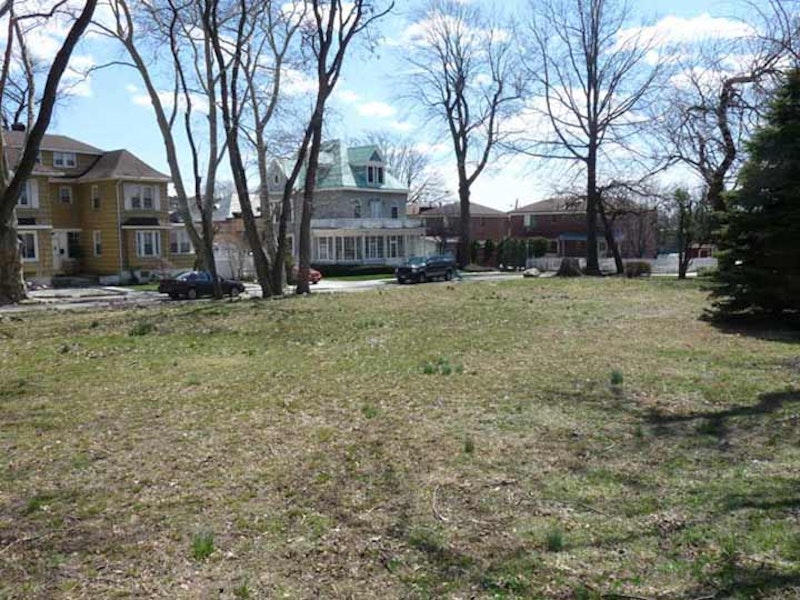One of College Point’s many features that should be considered by the Landmarks Preservation Commission is Beech Court or Beech Court Circle, located on a cul-de-sac at 121st St. just off 14th Ave. While such an arrangement—a group of private homes surrounding a central green—is popular in the suburbs, this may be the only such occurrence in New York City.
A little background on the area: College Point was originally settled by the Native-American Matinecocks. The Indians sold much of it to New Netherland Governor William Kieft in 1645. William Lawrence was the first British settler. (College Point Boulevard’s name until 1969, Lawrence St., honored the Lawrence family.)
Communities known as Strattonport and Flammersberg united to form College Point in 1867. College Point gets its name from St. Paul’s College, founded in 1838 as a seminary by the Rev. Augustus Muhlenberg, the rector of St. George’s Church on Main St. in Flushing. But there’s no college in College Point now. St. Paul’s College foundered within a decade, and by about 1850 was converted into an elementary school and then a summer resort.
An entrepreneur named Conrad Poppenhusen built downtown College Point to house his factory workers, and it’s still his legacy that shapes College Point to this day. Manufacturer Poppenhusen (1818-1883) arrived here from Germany in 1854 and converted College Point into a virtual company town. Poppenhusen opened a large hard rubber factory (hard rubber was the plastic of its day) employing hundreds of immigrant workers and native College Pointers. The factory produced rubber products, combs, dental and medical goods and hardware.
Poppenhusen also built the Flushing and North Side Railroad, now a part of the LIRR Port Washington line, and later owned the LIRR between 1876 and 1879. Poppenhusen built water and sewage systems, a library, and the Poppenhusen Institute. He’s recalled by the Institute, an avenue, and an 1884 bust by Henry Baehrer at Poppenhusen Triangle at College Place and 12th Ave., at the approximate spot where his mansion used to stand.

Unsurprisingly (this is Queens) there are only three landmarked structures or areas in College Point. One is the Poppenhusen Institute, perched on the outskirts of town on 14th Rd. and 114th St., constructed in 1868 and partially funded by Poppenhusen on the occasion of his 50th birthday. Another is the Schleicher Mansion, a.k.a. the Grand View Hotel, now an apartment building. It’s an 1853 former mansion standing in its own traffic circle at 13th Ave. and 123rd St.. The third is the Poppenhusen Library, built in 1904 with funds donated by the Scottish philanthropist/industrialist Andrew Carnegie.

Beech Court serves as a last remnant of the originally quite extensive Herman Funke Estate in College Point. As the site remains un-landmarked, information about it online remains sketchy, and only a lengthy delve into College Point real estate records will likely turn up the Court’s original developer. I’ve circled Beech Court as it appears on a 1909 Bromley Queens atlas, above. At this time the development was new; notice that only two homes had been constructed.

Casual visitors to Beech Court will find an architectural wonderworld. Sidewalks are in bad shape after the hard winter, and a legacy of the Court’s formerly private nature is that the Department of Transportation doesn’t deign to install lampposts. At night, only the lights of the buildings ringing the Court illuminate the pathway, which has seen everything from horses and carriages to modern sport utility vehicles.
The first building on the Court, Number 3, is an eclectic Queen Anne-type of house, with an interior porch protected from searing sun, clammy breezes, blizzards and bugs by many-paned windows. Residents who want to lounge outside can do so on the second-floor exposed porch, or daydream out the four dormer windows, one on the front, one in the back, two on the side.

Beech Court dispenses with the usual hyphenated Queens house number system. Its nine buildings are simply numbered in order, with some skipping from three to 12, with the mildly annoying exception of Nos. 12-44 and 12-46, a pair of attached houses that are the last on Beech Court as you proceed counterclockwise around the circle. Would you like to sit on this porch at No. 5 reading the paper, with an iced tea on some random 90-degree afternoon in July? I would.

A relatively recent addition to Beech Court must’ve been this streamlined Art Moderne classic at No. 10. The style was introduced at the Paris Exhibition of 1937. Other examples of the style include the curved-edge, thousand-windowed Starrett-Lehigh Building in Chelsea.

11 Beech Court, which features two bay windows on the ground floor, a three-window dormer, and a side porch, borders Boker Court, which was once the driveway to one of College Point’s grander mansions. Beech Court has been given a Queensmark for architectural elegance by the Queens Historical Society. However, these awards are largely ceremonial, and don’t guarantee the continued existence of the buildings or collections of buildings to which they are awarded.
—Kevin Walsh is the webmaster of the award-winning website Forgotten NY, and the author of the books Forgotten New York (HarperCollins, 2006) and also, with the Greater Astoria Historical Society, Forgotten Queens (Arcadia, 2013)

